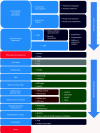Metagenomics for pathogen detection in public health
- PMID: 24050114
- PMCID: PMC3978900
- DOI: 10.1186/gm485
Metagenomics for pathogen detection in public health
Abstract
Traditional pathogen detection methods in public health infectious disease surveillance rely upon the identification of agents that are already known to be associated with a particular clinical syndrome. The emerging field of metagenomics has the potential to revolutionize pathogen detection in public health laboratories by allowing the simultaneous detection of all microorganisms in a clinical sample, without a priori knowledge of their identities, through the use of next-generation DNA sequencing. A single metagenomics analysis has the potential to detect rare and novel pathogens, and to uncover the role of dysbiotic microbiomes in infectious and chronic human disease. Making use of advances in sequencing platforms and bioinformatics tools, recent studies have shown that metagenomics can even determine the whole-genome sequences of pathogens, allowing inferences about antibiotic resistance, virulence, evolution and transmission to be made. We are entering an era in which more novel infectious diseases will be identified through metagenomics-based methods than through traditional laboratory methods. The impetus is now on public health laboratories to integrate metagenomics techniques into their diagnostic arsenals.
Figures


References
-
- Ambrose HE, Granerod J, Clewley JP, Davies NW, Keir G, Cunningham R, Zuckerman M, Mutton KJ, Ward KN, Ijaz S, Crowcroft NS, Brown DW. UK Aetiology of Encephalitis Study Group. Diagnostic strategy used to establish etiologies of encephalitis in a prospective cohort of patients in England. J Clin Microbiol. 2011;5:3576–3583. doi: 10.1128/JCM.00862-11. - DOI - PMC - PubMed
-
- Kindler E, Jonsdottir HR, Muth D, Hamming OJ, Hartmann R, Rodriguez R, Geffers R, Fouchier RA, Drosten C, Muller MA, Dijkman R, Thiel V. Efficient replication of the novel human betacoronavirus EMC on primary human epithelium highlights its zoonotic potential. mBio. 2013;5:e00611–e00612. - PMC - PubMed
-
- Gao R, Cao B, Hu Y, Feng Z, Wang D, Hu W, Chen J, Jie Z, Qiu H, Xu K, Xu X, Lu H, Zhu W, Gao Z, Xiang N, Shen Y, He Z, Gu Y, Zhang Z, Yang Y, Zhao X, Zhou L, Li X, Zou S, Zhang Y, Li X, Yang L, Guo J, Dong J, Li Q. et al.Human infection with a novel avian-origin influenza A (H7N9) virus. New Engl J Med. 2013;5:1888–1897. doi: 10.1056/NEJMoa1304459. - DOI - PubMed
Publication types
LinkOut - more resources
Full Text Sources
Other Literature Sources

